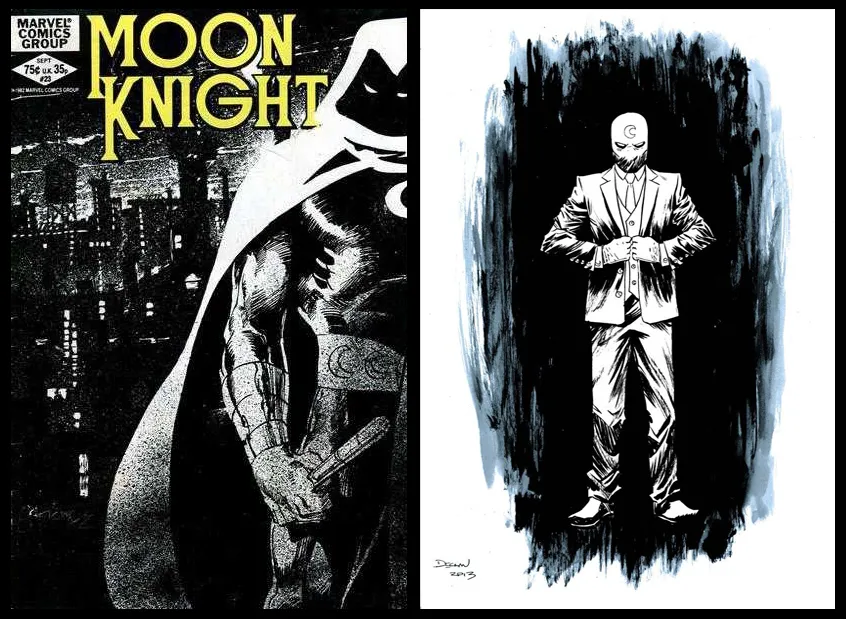Moon Knight is a cool character who, sadly, has often suffered from strange decisions and some creators not knowing what to do with him. Throughout it all, he’s remained Marc Spector, a former mercenary who became a vigilante cloaked in silver because he absolutely wants the bad guys to see him coming. Recently, writer Warren Ellis and artists Declan Shelvey and Jordie Bellaire have reinvented the character for the new ongoing Moon Knight series. I highly recommend it for fans old and new.
But before we chat any further about the new series, let’s delve into the history of this lunar avenger of the night who had to die before he could live as a hero.
MARC SPECTOR, WEREWOLF HUNTER
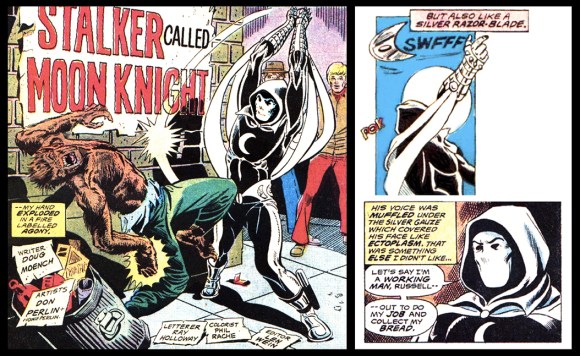
Moon Knight was created to be a werewolf fighter, first appearing in Werewolf by Night #32 (1975), written by Doug Moench (later known for many Batman stories), pencilled by Don Perlin and colored by Phil Rache. The series Werewolf by Night starred the cursed hero Jack Russell, whose enemies included a clandestine cabal of corrupt people called the Committee. In issue #32, the Committee decides to send Marcus Spector after Russell. It’s explained that Marc is a mercenary who used to be heavyweight boxer and a marine, a highly trained man with a bit of a mean streak and rebellious nature.
To fight the werewolf, the Committee gave Spector a silver costume with silver gauntlets, each with a silver cestus (spiked gloves) attached, silver throwing blades, and silver truncheons. This is about as anti-werewolf as your gear can get. It’s also intentionally ironic that a monster empowered/cursed by the moon would be hunted by a “Moon Knight.” Spector thought it was a dumb name but didn’t argue when the Committee gave it to him since he was getting paid.
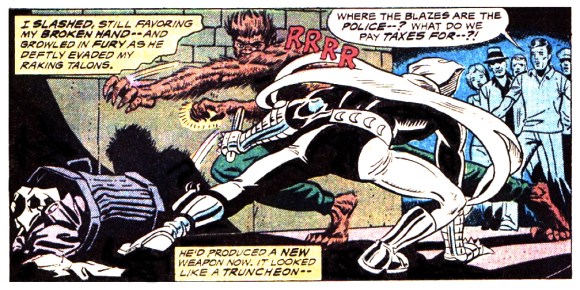
Notice Moon Knight’s first suit has a black shirt and black interior section of the trousers. White coloring is used to give texture. The gauntlets, boots, belt and cloak are all meant to be silver. The narration says Marc’s mask is “silver gauze which covered his face like ectoplasm.” The wing-like cape is attached directly to the gauntlets for use as a limited parachute/glider. Also notice, unlike the later versions, this outfit has a noticeable cape clasp and a collar separate from the hood. That last bit is indicative of Moon Knight being created in the 1970s. It’s not a bad suit but I worry having the cape attached to his gauntlets could add the awkward vulnerability of getting tangled or grabbed.
During his adventure with Jack Russell, Moon Knight realized this guy, werewolf or not, had more honor and decency to him than the Committee members. So he turned against his employers and went on his merry way, keeping the costume.
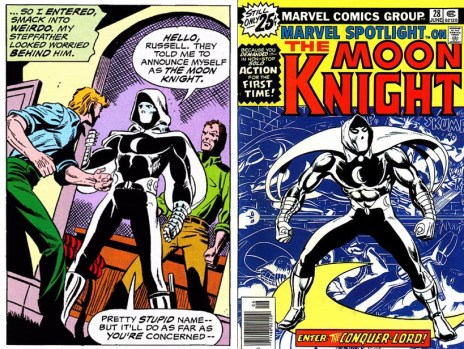
Moon Knight next appeared in Marvel Spotlight #28 and was now a vigilante. In keeping with the non-lethal tactics of the typical Marvel superhero, Moon Knight ditched the cesti gauntlets which ensured bloodshed and just wore silver gloves with his bracers. The mask was altered slightly, now with visible eye holes. Marvel Spotlight established Moon Knight used several cover identities to in his operations. One was a cab driver, later said to be named Jake Lockley, but his most frequently used identity was millionaire Steven Grant, a resident of Long Island, NY who mingled with the wealthy and powerful.
This premise is borrowed from the influential pulp fiction magazine character known as the Shadow. For years, the Shadow’s secret identity was wealthy Lamont Cranston. But readers knew this was not his true name, it was just a cover he’d adopted as his main civilian identity, and he had other covers to use when circumstances required it. After several years of stories, the Shadow was eventually revealed to have been mercenary and pilot Kent Allard, but he left that life and name behind when he came to New York to wage a war on crime. So if people tell you “Moon Knight is basically Batman,” you can counter “he has more in common with the Shadow.” Isn’t learning fun?
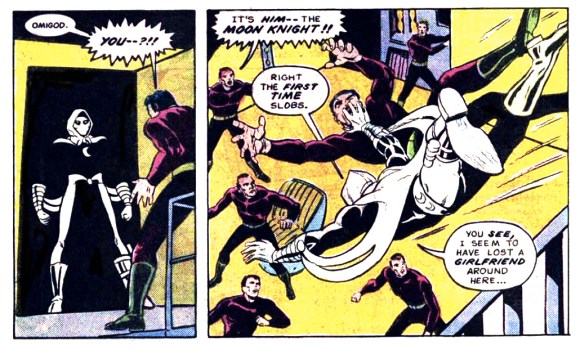
Along with his change from mercenary to vigilante, Moon Knight now had moon-based strength. His encounter with Jack Russell’s teeth had resulted in some werewolf saliva mixing with his blood. Under a dark new moon, Marc was just a highly athletic human, the waxing moon increased his strength, and a full moon took it to a superhuman level where he could lift roughly 2 tons over his head.
After his first solo adventure in Marvel Spotlight, Moon Knight made appearances in stories across the Marvel Universe, sometimes on his own and sometimes teaming up with superheroes. He also got a small supporting cast which included his lover Marlene Alraune and his buddy/pilot Jean-Paul “Frenchie” DuChamp.
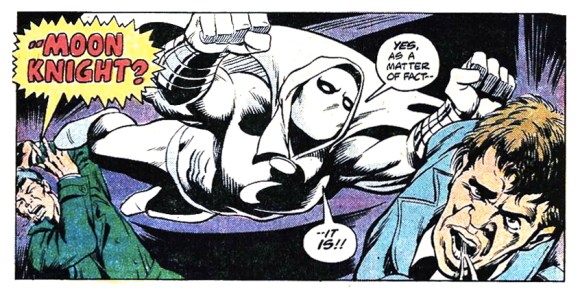
As the adventures went on, artists started coloring Moon Knight’s shirt to be white/silver like his hood and cape. Though it eliminated some nice contrast from the costume, the fact was it wasn’t always clear to readers anyway the shirt was supposed to be black. This happened to several other superheroes, such as Spider-Man whose black and red costume quickly became blue and red because of how the coloring style changed.
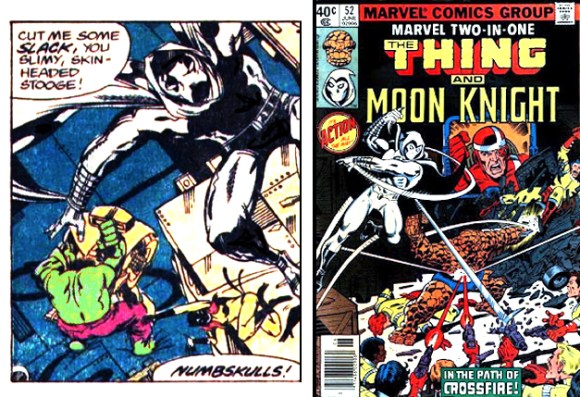
When he appeared in Defenders, Moon Knight’s trousers became all white as well, losing the interior black. Then, Marvel Two-In-One #52 (1979) had Moon Knight join forces with the Thing (not unexpected, as it was a Thing team-up series) while displaying yet another costume change. Starting in this issue, Moon Knight’s cape was finally set free, no longer attached to his bracers.
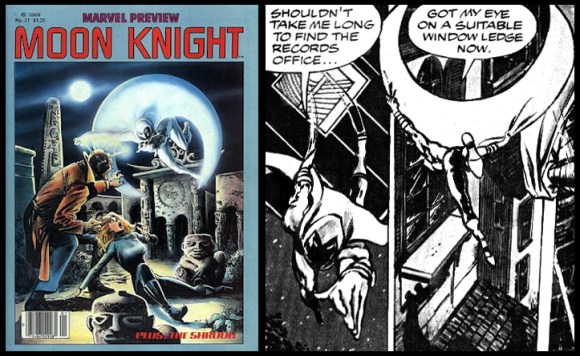
Moon Knight also received a solo feature in Marvel Preview. In these black and white tales, his glider cape extended in length and now took on the shape of a crescent moon when he grabbed its edges. This last change finally gave us what we now consider to be the first classic Moon Knight costume design. This is the costume he wore when he got his own series in 1980.
HIS OWN SERIES AT LAST
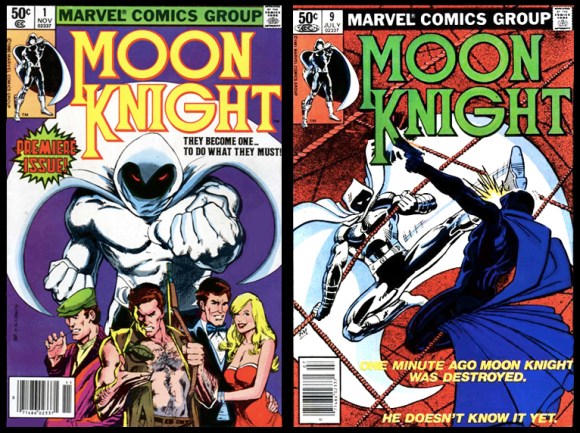
Moon Knight vol. 1 #1 came out in 1980. Written by Moon Knight creator Doug Moench, the new series retconned the hero’s origin. The in-universe history now said Marc Spector had been operating as the hero Moon Knight before he was ever hired by the Committee to fight Jack Russell. He’d only worked with the Committee to learn more about the criminal organization so he could disrupt their plans. So how the heck did Marc become the Moon Knight then?
The new origin reveals Marc Spector, during his mercenary days, is working in Egypt alongside his buddy Frenchie and Raoul Bushman, known for vicious methods and having literal steel teeth. One night, Bushman targets an archaeologist named Peter Alraune who recently discovered a hidden tomb of Pharaoh Seti I. Bushman wants the artifacts from the tomb and kills the archeologist when he didn’t comply, after which he opens fire on a nearby village. Appalled, Marc sends Dr. Alraune’s daughter Marlene away to safety and confronts Bushman. Marc is defeated and left in the desert to die. He wanders for some time until he is close to Seti I’s tomb and collapses. Marlene and others find him and bring him into the tomb, hoping to help. They place him nearby a statue of the moon god Khonshu (which oddly has an silver cloak decorating it), but it’s too late. Marc has no signs of life.
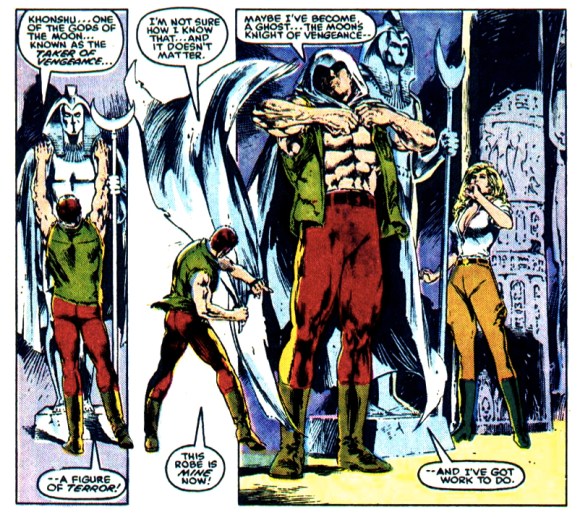
Moments later, Marc sits up and then stands to examine the statue of Khonshu. He claims the moon god has resurrected him. Marlene can’t explain Marc’s sudden recovery, but worries he’s delirious from dehydration and exhaustion. Marc glibly says he’s now a literal specter serving Khonshu, chosen to be “the moon’s knight of vengeance.” He dons the statue’s cloak and takes down Bushman, who from that point on is a recurring enemy. Believing Khonshu wants him to protect the innocent, he returns to the U.S., taking the cloak and statue with him. With the money he’d made as a merc, he sets up his new life as Steven Grant, then his cabbie cover as Jake Lockley, and starts his career as Moon Knight, designing his costume after Khonshu’s appearance.
Marvel also got rid of the idea of werewolf saliva giving him moon-based strength. Now, Moon Knight credited this lunar superpower to Khonshu’s influence. Some comics proposed this might have been another delusion and Marc just pushed his limits further and tapped into hidden strength because of his belief in Khonshu. Years later, the whole “the moon makes him stronger” idea was dropped. Whatever the case, NEW ORIGIN AND PREMISE UNLOCKED!
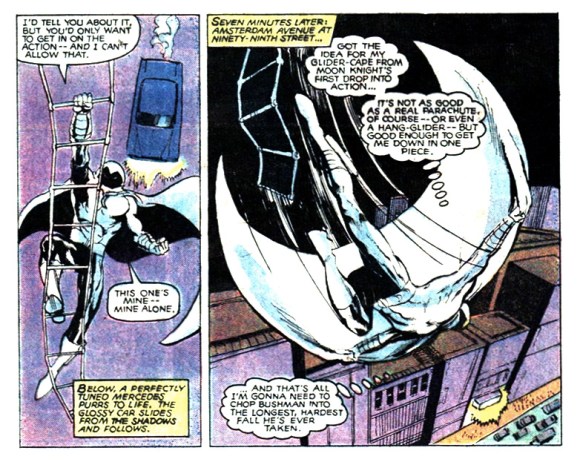
Though Doug Moench scripted this new origin, it came about through conversations and shared input between him, editor Jim Shooter and editor Denny O’Neil (who would later become the head editor of Batman for many years). According to O’Neil, he thought of the scene of Marcdying in front of the statue of Khonshu in a tomb and then reviving moments later, while Shooter and Moench figured out the rest.
Let’s briefly talk about the real Khonshu of Egyptian mythology. He is indeed a moon god, though his name is usually spelled as Khonsu or Chons. Rather than a white/silver figure with no face and a pharaoh’s headdress, he was often depicted as a young man in a silver/white robe or as a figure with the head of a falcon. In both cases, he wore a headdress of a crescent moon over a full moon disc.
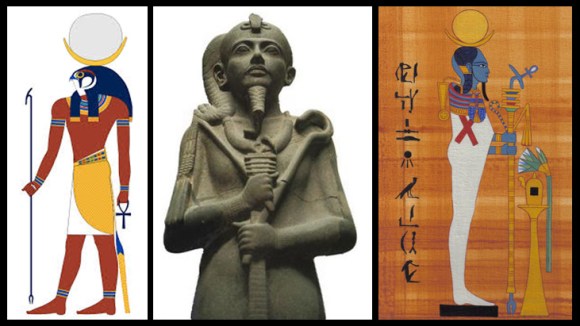
Early myths have him as a bloodthirsty and vengeful being, as well as a god-killer known as “The One Who Lives on Hearts.” He was said to have a rage which could destroy lives. As time passed, his role changed. Stories speak of him as a force of protection, healing, life and fertility. Since he was associated with light and the passage of time, he was also sometimes known as the “maker of men’s destinies.” One story says Khonsu helped in the creation of the universe, becoming a snake who fertilized a cosmic egg. It’s generally held his name means “Traveler,” referencing the moon’s journeys across the sky and the fact that Khonsu looked over those who traveled at night.
Moon Knight’s costume doesn’t resemble the real Khonsu. But that’s ok. His connection to the moon god was decided on five years after he was created. Marvel’s Thor doesn’t physically resemble the Thor of actual mythology either (and the reason for that was eventually explained through reincarnation). All in all, Moon Knight’s classic suit is still pretty cool. Once he got his own series, his mask would sometimes go from being white and in shadow to being a literal black mask and then back again.
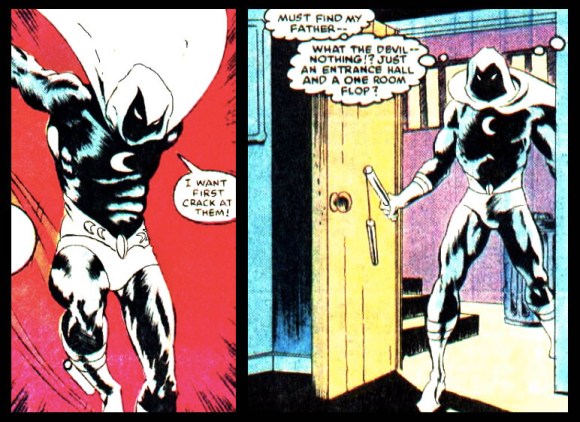
During this time, Moon Knight’s costume evolved a little more. His gloves were simplified, no longer decorated by bracers. He now had visible white shorts on over his trousers. The trousers and the shirt darkened, intended to be black with a silver sheen for texture. Some stories still called him a “jet and silver” hero or the “jet black and silver avenger.”
Now here’s a funny thing. Despite the fact the Marvel Universe says many gods of Earth’s history were living beings from other worlds or dimensions, the Moon Knight comics kept it very sketchy as to whether or not Marc had actually been tapped by such a being or had hallucinated the encounter. Maybe he wasn’t dead and then resurrected, maybe he was just extremely weak and had a miraculous recovery. You’d think Marc could have just asked Thor, who’d met the Egyptian gods, if he could contact the real Khonshu and verify his beliefs, but this didn’t happen. Basically, Marvel wanted readers to wonder if the crescent moon crusader was also a lunatic. I guess that was only natural when you have a hero connected to the moon and the pun is just too tempting.
Going along with the “is he a nuts or not” theme, the Moon Knight series eventually had Marc develop Multiple Personality Disorder (which today is known as Dissociative Identity Disorder), a result of the stress of maintaining multiple cover identities on a regular basis. Even for superhero comics, this is ridiculous. Although the diagnosis has controversy and disagreement about it, the research is clear that DID is not something you catch or develop by adopting different identities on a regular basis. Otherwise, actors of all sorts would widely suffer form it. But that’s what the comics said and it wasn’t until 2014 we were told differently.
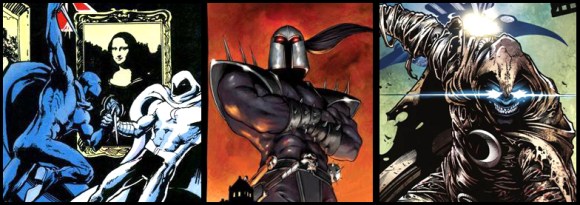
Before we move on, it’s interesting to note Moon Knight habitually finds enemies who visually model themselves after him. During his first solo series, he fought the villain Anton Mogart aka Midnight Man, who dressed in a similar costume that was completely black, and Carson Knowles aka the Black Spectre, who fancied himself an anti-thesis to Moon Knight. Marc also fought his own brother Randall, who became the serial killer Hatchet-Man before his untimely death. In the 1990s, history was retconned and the dead Hatchet-Man was said to be someone else entirely. Randall was reintroduced at the same time as Shadow Knight, who wanted to usurp Moon Knight’s place as Khonshu’s champion and later dressed as a mummy version of the hero. Odd how Marc keeps inspiring mimicry in villains.
The first Moon Knight series was cancelled with issue #38 in the summer of 1984. After the god Khonshu intervened and healed Marc Spector’s fragmented mind, the hero had one last adventure which involved his father and non-literal ghosts of his past. He then decided to retire from the superhero life so he could go live happily ever after with Marlene. Of course, readers were told in the same issue that Moon Knight would be back the following year.
FIST OF KHONSHU
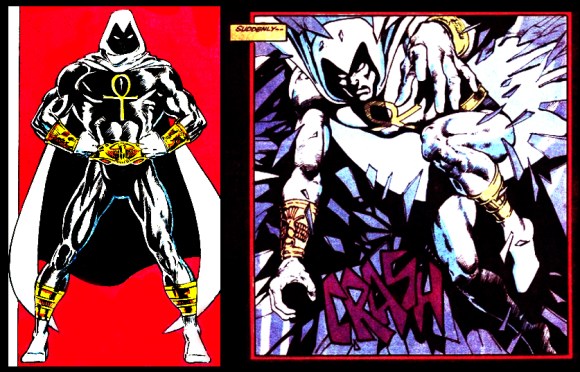
In 1985, the silver-garbed avenger of evil reappeared in the six-issue mini-series Moon Knight: Fist of Khonshu. It was written by Alan Zelenetz (who had been the last writer on the previous series), with art by Chris Warner, Christie Scheele and E.R. Cruz. The story began with Marc Spector and Marlene living their quiet lives. Marc set up the Spector International Art Gallery and wound up auctioning the Khonshu statue he had held onto for years. Seems a little messed up to auction off the statue instead of, I don’t know, returning it to Egypt since you kinda stole it. But I digress.
Marc has visions of Khonshu telling him evil is rising in Egypt. Marc tells Marlene he has to investigate, but she gets angry he’s returning to his old insane life and leaves. Marc then heads to the Valley of Kings and discovers a cave inhabited by a priesthood dedicated to Khonshu. He learns of an ancient priest of Anubis named Araamses who was mummified thousands of years before, his body placed in the very tomb in which Marc later experienced his resurrection. Just as Marc was revived to serve Khonshu, Araamses was resurrected to serve Anubis. In actual mythology, Anubis was an afterlife god who judged the dead before they went to their final fate and protected the spirits of the innocent. But in Marvel Comics, he was seen as an aspect of death and therefore a bad guy who was the opposite number of Khonshu, who represented healing and life, as well as vengeance.
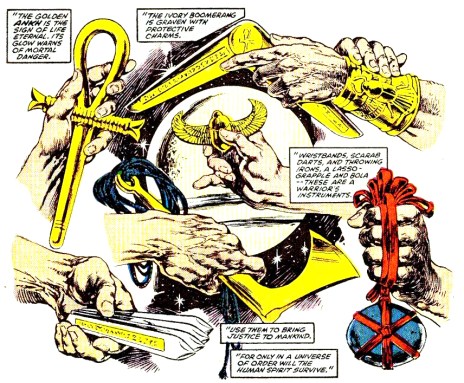
In any event, the priests knew Araamses was now rising in power, thanks in part to his having bought the statue of Khonshu from Marc’s auction. Marc had to become Moon Knight again, to act as the fist of Khonshu on Earth, so he could recover the statue and stop Araamses, who was now an avatar of Anubis. To help, the priests gave Marc new weapons magically charmed to aid against evil, such as a metal ankh that would glow to warn of nearby danger (and orcs, presumably). They also granted him a new suit decorated by the ankh (a symbol of life), a golden belt, and golden bracers. So Moon Knight was given a soft reboot, donning a new costume and becoming a man who fought mystical forces rather than serial killers and gangsters.
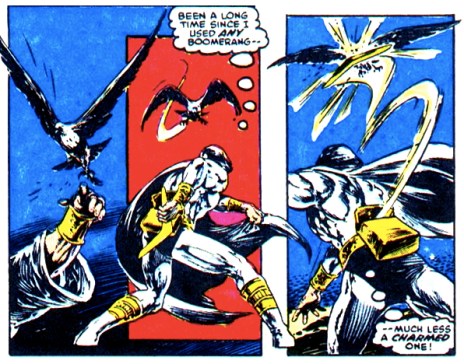
To carry all this new stuff, Moony had a new pouch attached to the back of his belt. Honestly, he probably should’ve kept the bag more to the side. Keeping it directly on the back of his belt seems like it would be a little awkward to reach during a fight. Maybe I’m just not flexible enough myself.
This is a pretty cool costume but I’m not sure it works for our hero. I can get behind how the bracers and belt break up the costume’s color. But now we’ve got a guy called Moon Knight with not one single moon symbol? Doesn’t work. Add to this the fact that artists started making Marc’s face visible underneath the mask and this almost becomes a different character.
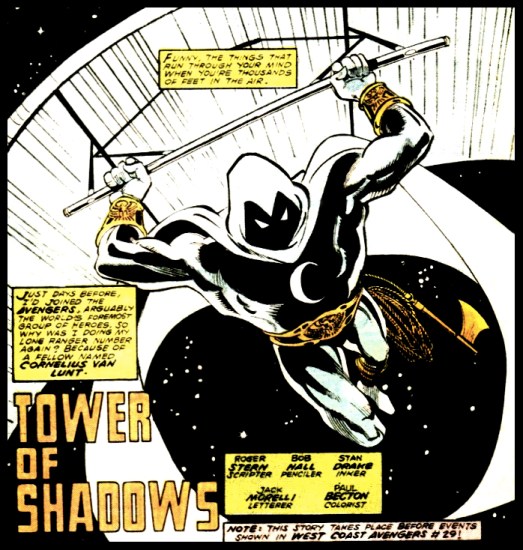
After Moon Knight: Fist of Khonshu ended, Moon Knight appeared in West Coast Avengers (which was later retitled Avengers West Coast) and served as a member of the team for over a year. When he joined the team, he had already altered his costume slightly, switching the ankh for a crescent moon. During a time travel adventure, it was revealed the Avenger named Hawkeye had actually designed the golden weapons Moon Knight had received from the Khonshu priests. Aren’t paradoxes fun? Screw you, causality!
While still with the Avengers West Coast branch, Moon Knight learned that Khonshu had actually entered his mind during the Fist of Khonshu mini-series and had been influencing his behavior since then. With the help of the demonic sorcerer Damian Hellstrom, Marc exorcised Khonshu. He then decided to retire from superheroics, at least for a while. He left the Avengers and ditched the costume and charmed weapons he’d been using for a few years.
BACK TO BASICS
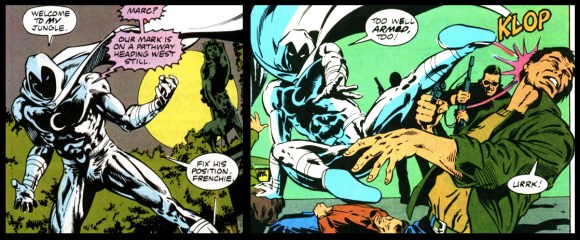
In 1989, the “jet black and silver Avenger” got his own series again. Marc Spector: Moon Knight #1 was initially written by Chuck Dixon (who later wrote a lot of Batman, Robin and Green Arrow comics), and originally had the art team of Sal Velluto, Mark Farmer and Mark Chiarello. The series opened with Marc resuming his crime-fighting life, donning the look he’d worn at the end of the first Moon Knight series. A minor change was the belt buckle was now a crescent moon too. Marc had Frenchie at his side again and Marlene returned quickly afterward. In this series, he didn’t run around as Steven Grant or Jake Lockely. He was simply Marc Spector, a guy with resources and a crescent shaped “Moon-Copter” who sometimes wore a costume and beat up bad people. Once again, his villains were more urban-based rather than cosmic.

After a few adventures, Marc’s costume changed slightly. Along with now being made of light-weight kevlar, the suit had the arm bracers Moon Knight had worn originally in the 70’s and added similar armor to the boots. I rather like this look, which has been considered his second “classic” costume. The boots and gloves matching gives a nice unity to the suit. The shirt and trousers were now often indicated to be black again, with silver highlights, while the cloak remained white/silver. It became standard to keep Moon Knight’s masked face in shadow, so you often couldn’t tell if it was black or white or something else.
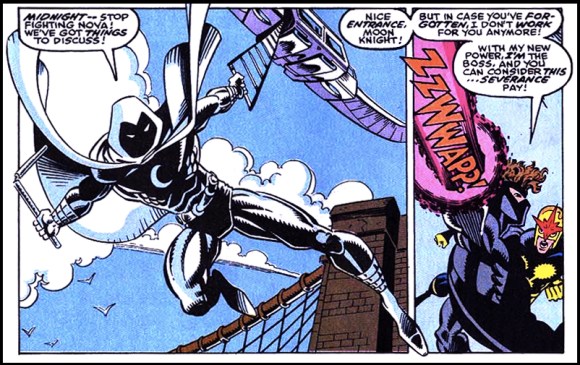
During this series, Moon Knight met the young vigilante Jeff Wilde aka Midnight, son of the deceased criminal Midnight Man. Jeff had become a vigilante following Moon Knight’s disappearance from New York and now wanted to work with him, so Marc took on the teenager as a sidekick. But Jeff was too impulsive and wound up getting seemingly killed during a battle with the terrorist organization known as the Secret Empire. Not long afterward, we learned he had survived his injuries thanks to the Secret Empire rebuilding him as a cyborg. Jeff now served the terrorist group and wanted revenge on Moon Knight, whom he believed had deliberately abandoned him and caused Midnight Man’s death. It’s rather like the story of Captain America and the Winter Soldier over a decade later. Except we never liked Jeff much (he was a bit of a whiner), so we didn’t feel the tragedy that strongly.
Terry Kavanagh took over as writer and from then on the series got pretty weird. Marc set up his own company SpectorCorp, along with a think-tank he called Shadow Cabinet, all intelligent and skilled people he contacted via hologram. His lair, the ShadowKeep, was a high-tech place which came to include more vehicles such as the Angelwing and the Moon-Mobile. Yeah. “Moon-Mobile.” I guess it’s not that far out when you’ve already been using a Moon-Copter for years.
The Shadow Cabinet included a psychologist codenamed Sigmund who told Marc he still suffered from multiple personalities and had only been repressing the condition. Kavanagh also revealed that Marc was descended from a demon clan known as the Hellbent. It was a weird time for the lunar avenger, people. Thankfully, no one’s ever mentioned the Hellbent since this series.
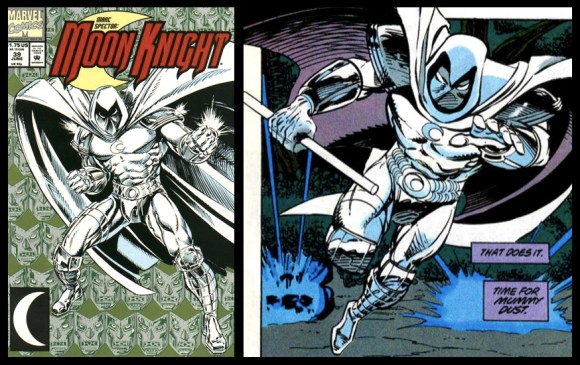
An encounter with the Spider-Man villain Hobgoblin (demonically possessed, at the time) led to Moon Knight being infected by a demon force that ravaged his health. To compensate, he adopted a silver suit of armor. This design isn’t bad, but there are too many moons on the belt and it definitely takes away the feeling of agility the hero always had. He’s a “knight,” but he shouldn’t look like he raided Iron Man’s closet. It also makes it seem doubtful his glider cape could really hold him aloft.
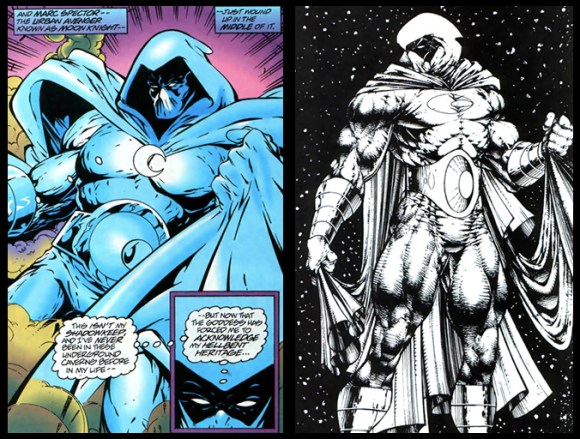
In the final storyline of Marc Spector: Moon Knight, the silver-garbed hero regained his health and ditched the armor. He started wearing an all white/silver version of his second classic suit, except he added a new belt with a big honking moon buckle. Seriously, that is an enormous buckle. Is Marc hiding a roomba there in case he needs to do some vacuuming at a moment’s notice?
Anyway, sales had been down for a while and it was decided to retire the hero again, maybe for good. In the final issue of Marc Spector: Moon Knight, an enemy unleashed a computer virus to cause widespread destruction. After evacuating the SpectorCorp HQ, Marc confined the destruction to that building, sacrificing himself. Marlene found his body and the issue ended with a funeral.
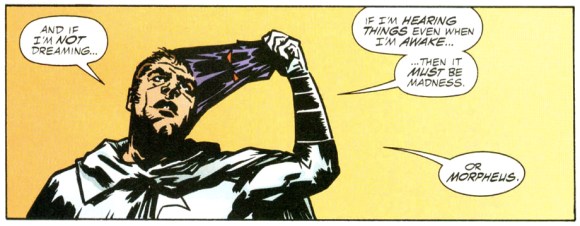
Of course, this is superhero comics. So what’s a little resurrection between friends, especially with a hero who’s already pulled off that trick once? Doug Moench came back to write the mini-series Moon Knight: The Resurrection War, wherein Khonshu apparently returns Marc to life so he can fight some old enemies and the forces of the god Set. The mini-series mainly served to restore the hero to the status quo of Moench’s stories during the original solo series. Moon Knight again abandoned the Spector identity and resumed his covers as Grant and Lockley. Despite the fact that West Coast Avengers had confirmed Khonshu was real and connected to Marc, The Resurrection War went back to implying the hero might be delusional. Marlene and Frenchie had buried Marc and then saw him returned to life before their eyes months later, but they wondered if maybe this and the hero’s (second) death were just illusions cast by his dream-based enemy Morpheus (though why the villain would do that wasn’t clear).
Marc Spector’s second resurrection marked the beginning of a new era, during which no one seemed to know what to do with the character. Moon Knight showed up in Black Panther comics and a Great Lakes Avengers special. Then, in the short-lived series Marvel Knights, he joined forces with other heroes determined to stop the Punisher. In the end, things didn’t work out and the destruction of Marc Spector’s new HQ left him with a serious lack of resources. He figured, “Frak it, I’m retiring. AGAIN.”
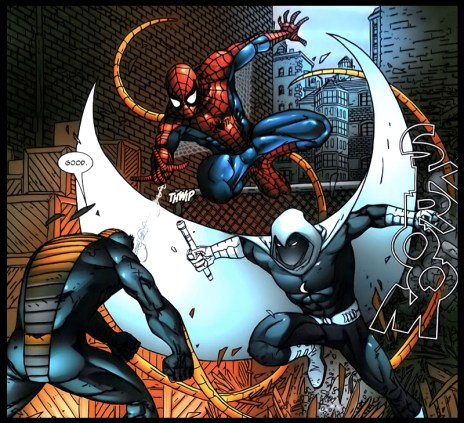
Retirement didn’t last long. Moon Knight reappeared in 2005 in the pages of Marvel Team-Up #7, written by Robert Kirkman (The Walking Dead), with art by Scott Kollins and Studio F. Here, he wore an all-black suit with a white cloak. Basically, this the second classic costume (with the first classic costume’s belt buckle) but we’ve eliminated the use of white highlights to give it texture. Coloring techniques had changed enough that we could give it texture and keep it totally black. It’s a curious effect.
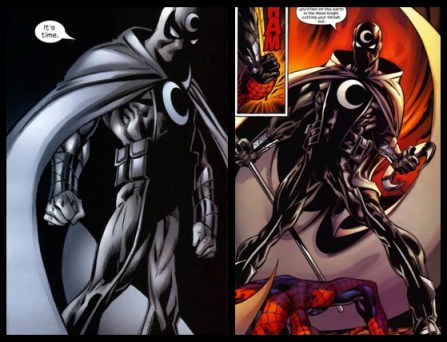
Another alternate look appeared in the Ultimate Marvel universe. Ultimate Marvel began in 2001, reimagining familiar Marvel characters in a new, slightly grittier reality. Ultimate Moon Knight had an interesting design done by Mark Bagley. The dark section that goes down the middle recalls the original 70’s suit. The crescent moon on the mask ain’t bad at all. But I miss the hood and that large collar just looks odd as a replacement.
MOON KNIGHT ACTUALLY GOES CRAZY
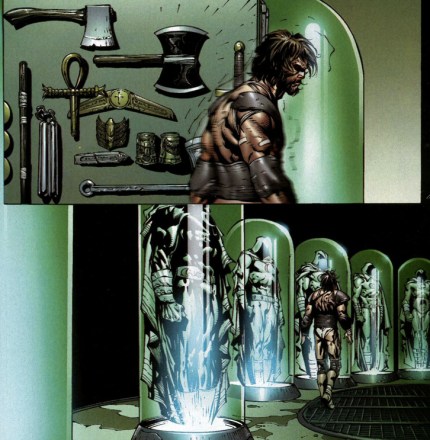
The hero got his own series again in 2006, around the time Marvel had its big Civil War crossover. The first issue of the new Moon Knight series, written by horror scribe Charlie Huston and with art by David Finch, revealed that since we’d last seen him in Marvel Knights, Marc had finally killed Bushman (I guess after his team-up with Spider-Man in 2005). Not only that, he’d actually sliced Bushman’s face off. It was, frankly, out of character for Moon Knight to be so vicious in his actions, but that was the story we were given. For the next few years, Moon Knight was emphasized as an unhinged and violent hero.
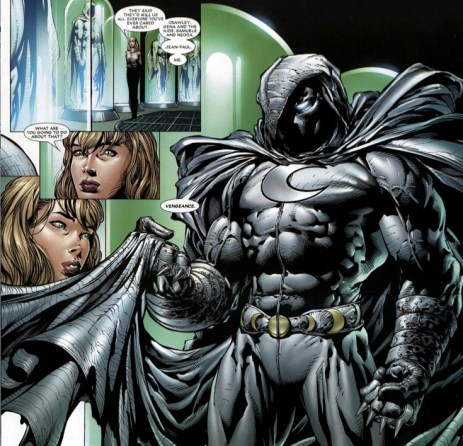
Marc had been injured by his final fight with Bushman and retired in depression, but circumstances led to him resuming his role as Moon Knight, now more violent and ruthless. He brought back the cesti he hadn’t worn since fighting Jack Russell in his first story. I’m not a fan of the spiked gloves since I don’t think Moon Knight should use them on just anyone, but the rest of the costume works. The crescent moon blades and belt buckle now being golden is a nice tweak. Along with the new wardrobe, Marc started having full on conversations with Khonshu, who appeared to him as Bushman’s faceless body. Khonshu’s aspects as a protector and healer were forgotten. He was interested in vengeance and insisted Marc be more lethal and vicious.
A fun thing Huston added to the Moon Knight mythos was an explanation for why the hero would wear a silver costume when he often operated at night. Marc recalled how Hawkeye had once asked him about this during his time on the West Coast branch of the Avengers. Moon Knight had explained, quite simply, he wanted his enemies to see him coming. He wanted them to be afraid, to focus on him and nothing else.
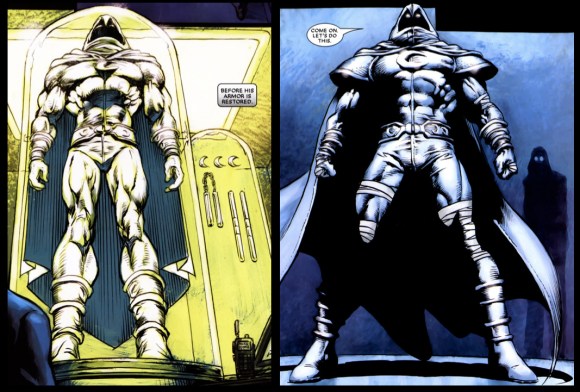
Although Huston stuck around as co-plotter for a while, he soon turned over writing duties to Mike Benson. Following the events of Civil War, Moon Knight registered with the government as a licensed hero and dropped the potentially lethal spiked gloves. The gold also went away, giving us an all-white look with new ribbed bracers and boots that had little crescent moons decorating them. In issue #19 (2008), he added shoulder pads to the suit.
That same issue involved a confrontation with Black Spectre which ended when Marc threw the villain off a rooftop to stop him from endangering lives. The fall was fatal and the act was witnessed by a crowd. Khonshu seemed pleased by this, but Marc decided that was the last time he would kill for the god of the moon. He wanted to be a hero, not a killer. To evade the authorities, he soon faked his death, then went to Mexico City and lived there for a while as Jake Lockley. The series then ended with Moon Knight #30 in 2009.
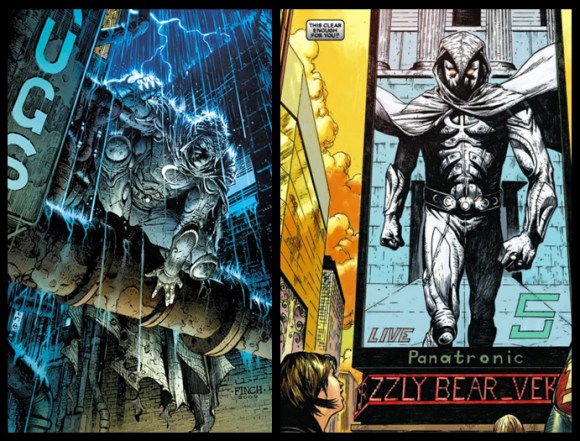
Later that year, the new series Vengeance of the Moon Knight began, written by Gregg Hurtwitz with art by Jerome Opeña and Dan Brown. The series had Moon Knight, now driven primarily by the Jake Lockley personality, return to New York in a new suit of armor. Jake Lockley was a different sort of hero, prone to alcohol abuse and perfectly fine with using guns rather than crescent blades. Though he wasn’t killing criminals like the Punisher, Moon Knight was still painted as a violent loose cannon.
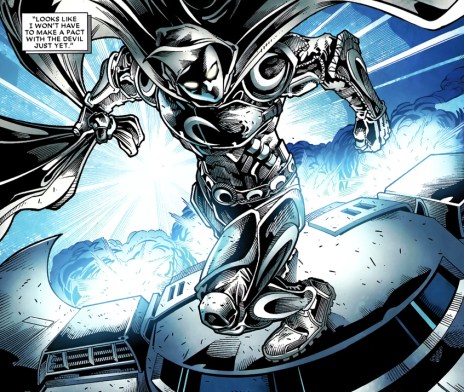
Now this new armor suit here. I get Moon Knight likes his symbol but holy crap, those are LOTS of crescent moons decorating that armor. They are all over the place! Shoulder pads, thigh armor, boots, bracers. Now, it looks like Moony is seriously self-conscious you aren’t going to remember who he is. And once again, my own opinion, Moon Knight shouldn’t wear too much armor.

Vengeance of the Moon Knight lasted less than a year. Moon Knight ditched the Jake Lockley identity and went back to being Marc Spector. Calmer and less violent now, he joined the Secret Avengers team for a while, performing covert missions for Steve Rogers. A couple of teammates were suspicious of him, due to his known history with mental illness. While on the team, he wore a few specialty costumes. When Warren Ellis took over as writer, one of his issues involved Moon Knight wearing a capeless versions of a classic suit, with a small back-pack then Moon Knight revealed the backpack actually held his cape, which expanded on command. A very cool idea!
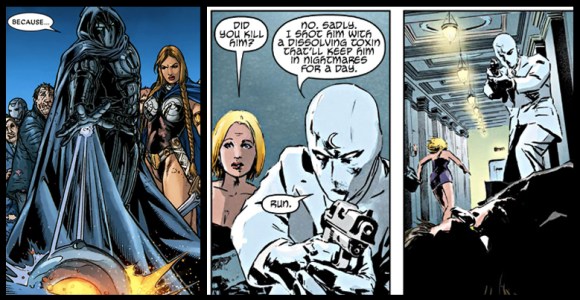
Another variation seen was an all-black version of his Vengeance of Moon Knight armor, worn for a night mission where stealth was more essential than Marc’s desire to scare baddies. It’s a cute alternate, but obviously it doesn’t work as a standard uniform for the lunar hero.
There was a plain clothes outfit introduced in Secret Avengers #19, written by Ellis, with art by Michael Lark, Stefano Gaudiano, and Brian Thies. In that story, Moon Knight was on a spy mission and just wore a white suit. When he had to go into action, he switched his red tie for a silver one and donned a simple white/silver mask decorated by a crescent moon. It was a great look and has recently resurfaced. During this story, he also used a dart gun that fired nightmare-inducing toxins.
It’s probably not a coincidence that Moon Knight’s white suit resembles the wardrobe of Elijah Snow, the main protagonist of Warren Ellis’ science fiction saga Planetary.

A new Moon Knight series kicked off in 2011, written by Brian Michael Bendis, with art by Alex Maleev and Matthew Wilson. In this story, Marc moved back to Los Angeles and became executive producer of a new TV show Legends of Khonshu, based on his own life (wait, what?). He also resumed his Moon Knight operations, wearing the first classic 1980s suit. There was no personality difference between Marc Spector and Moon Knight, so this was just one identity who sometimes wore a mask.
But Moon Knight wasn’t stable. Bendis brought back the idea of Marc’s splintered mind and added a new twist. Instead of adopting cover identities such as Jake Lockley and Steven Grant, Marc now occasionally had full blown hallucinations that Spider-Man, Wolverine and Captain America were present and talking with him. At times, he dressed up as them, convinced he was actually them. He’d wear Spidey’s suit or use weapons resembling Wolverine’s claws. He even got his own version of Captain America’s shield. Once again, Moon Knight was actually four people in one.
This kind of behavior doesn’t jive with either schizophrenia or Dissociative Identity Disorder. But as with the 1980s series, real psychology wasn’t the focus. The point you were meant to accept was that Moony was a loonie (don’t hate me, readers, I like rhymes). This series lasted just a year, by which point Marc had also developed an Iron Man personality.
2014 REBOOT
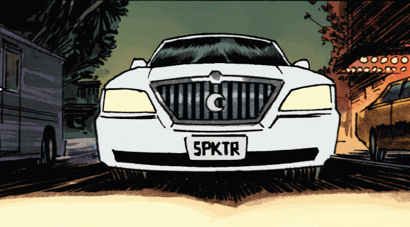
“I’ve died before. It was boring, so I stood up.”
A Moon Knight series has begun in 2014, written by Ellis, with art by Declan Shelvey and Jordie Bellaire. Marc Spector has returned to New York and resumed his crime-fighting activities, once again using considerable financial resources to outfit himself with cool, sexy vehicles and equipment. Ellis has, thankfully, done away with the idea Moon Knight has DID or schizophrenia. In issue #1, Marc visits a therapist who directly acknowledges that his symptoms do not match these conditions and furthermore, it’s ridiculous he would develop it through the strain of maintaining different cover identities.
As Ellis explains it, the different aspects of Khonshu in mythology fit into four basic categories: pathfinder, embracer, defender and the watcher of overnight travelers. It’s no coincidence Moon Knight often engages in up to four different identities at a time. All of Marc’s splintered personalities were actually because he was shifting between Khonshu’s different aspects. The Moon Knight aspect represented the Khonsu of myth who primarily protects and avenges those who wish to travel about at night in peace. Marc’s most violent period, when he took off Bushman’s face, was him acting as Khonshu’s earliest and most vengeful aspect, “The One Who Lives On Hearts.”
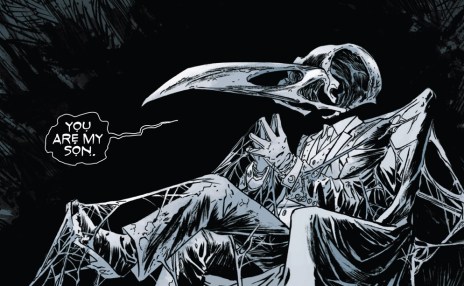
Marc wasn’t crazy, Khonshu was real, an extra-dimensional consciousness who had been worshipped as a god long ago. Marc had died and been resurrected by Khonshu, but brain damage had still resulted from his death. The moon god bonded with Marc’s mind and altered it somewhat so the resurrected mercenary would be his avatar. In the new series, Khonshu once again appears to Marc from time to time, now as a dead anthropomorphic falcon. This jives with the fact that in myth, Khonshu was often depicted with a falcon’s head.
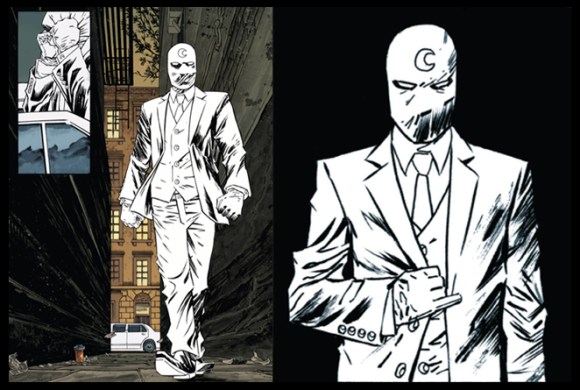
In the new series, Moon Knight actually uses two costumed aspects. One is the superhero who has a big cape and a black suit decorated by silver armor. The other is “Mr. Knight,” a consultant to the NYPD who wears a new version of the plainclothes look seen in Secret Avengers #19.
The Mr. Knight suit is awesome. I love this idea. In this three piece suit aspect, Moon Knight acts a little more like his old Steven Grant identity. Another thing I dig about this aspect is Mr. Knight’s buttons and cufflinks are all crescent moons. Unlike the Vengeance of the Moon Knight armor, they’re so small that they’re kind of adorable rather than overwhelming. In fact, I think I might have identical cufflinks and buttons made for me so I can add them to my own white suit. Yes, I own a white suit. What’s it to you?
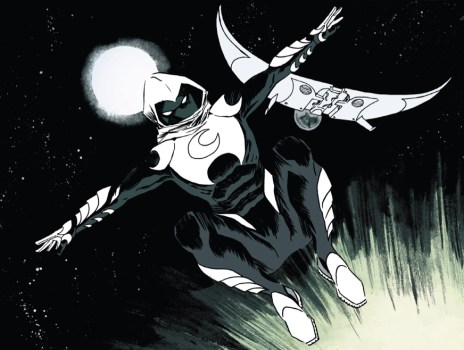
Now, about the new Moon Knight armor. People, I am all about this armor. I liked the 1990s classic style suit, but this is a slick ultra-modern update. Like the Marvel Team-Up version, it’s clearly a black bodysuit rather than one with white highlights. But now there’s enough silver armor added into the mix to add contrast and keep the costume from looking like a long-sleeved unitard. Once again, he can accurately be described as the “jet black and silver avenger.”
This suit also has a bit of a ninja aspect to it, which I think very much fits how Moon Knight operates. The over-lapping, flexible plates attached to parts of his body maintains a sense of freedom and agility, as opposed to the heavier, full armor suits of the past. With this design, he’s definitely an armored “knight,” but he doesn’t look so weighted down we’d have difficulty imagining him somersaulting off a rooftop.
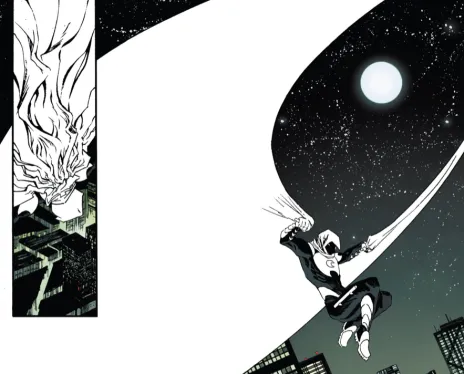
Ellis has also brought back the idea he used in Secret Avengers that Moon Knight’s glider cape can hide in his backpack and expand when necessary. This is a great idea. Along with the cape being a crescent moon, most of the armor plates are crescent shaped. But their placement on the armor prevent them from overwhelming the design with Moon Knight’s symbol. This is just one damn sharp suit, people.
Well, that wraps it up. This new Moon Knight series has only recently started, so you should have no problem catching up if you head to your local comic shop and ask for the previous issues. I highly recommend the series if you want to see urban crime-fighting tales with touches of high-concept science fiction and mysticism. Until next time, everyone, this is Alan Kistler, Agent of S.T.Y.L.E., signing off.
And hey, are you going to be at WonderCon? I’m speaking on a panel every day. Come say hi!
Alan Sizzler Kistler (@SizzlerKistler) is a freelance contributor and actor. He is the author of Doctor Who: A History.
Are you following The Mary Sue on Twitter, Facebook, Tumblr, Pinterest, & Google +?



